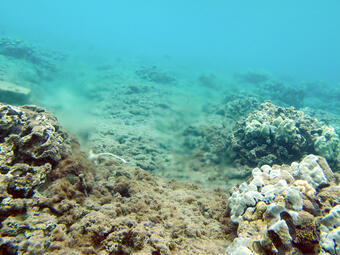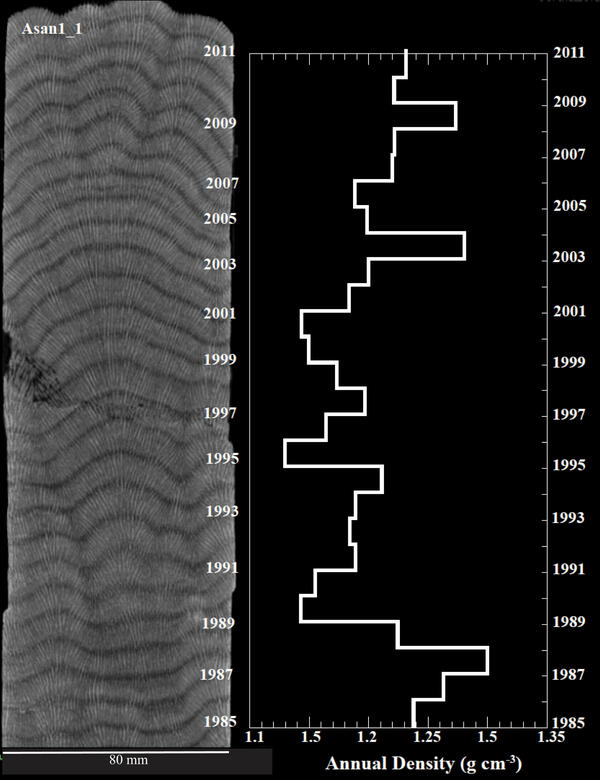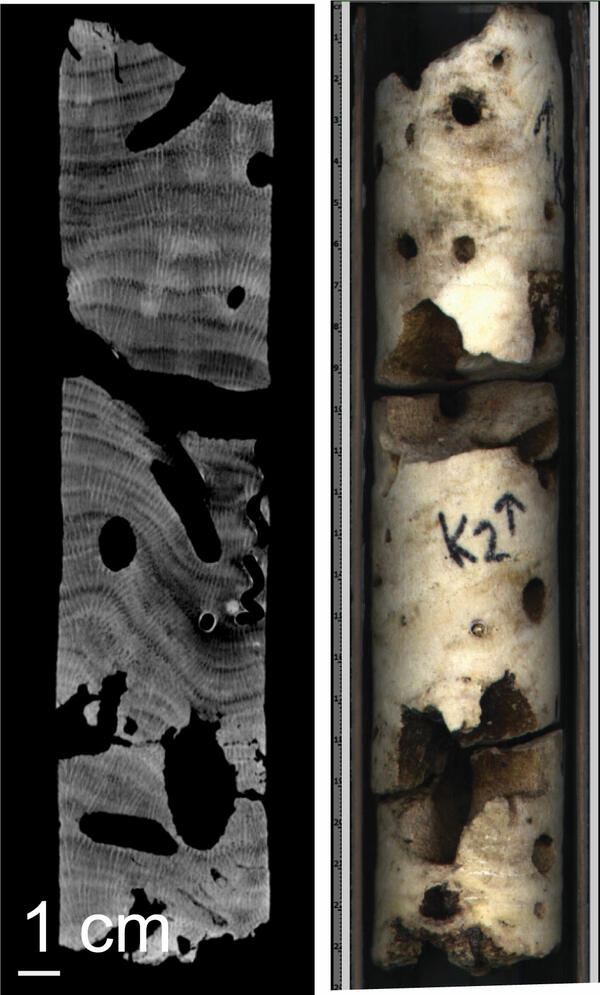Climate Change and Land-use Histories
As part of the USGS Coral Reef Project, we are developing new and unique oceanographic and environmental archives from coral skeleton records to better understand the compounding effects of land-use and environmental change on coral reef health.
The Problem
In addition to overfishing, physical damage, and coastal development, declining water quality is one of the most serious and sustained threats to coral reefs and is thought to be a primary cause of the global decline in shallow coral reefs. Isolating the effects of water quality stressors is difficult without determining the physical and biological controls on reef health. However, to evaluate recent trends and establish links to environmental and land-use change, there is a need to put these changes into a temporal and spatial context in order to identify thresholds and ranges of variability in the environment.
Our Approach

By measuring both physical changes (such as bioerosion, calcification, and growth rate) and chemical variations, records of climate change and land-use histories can be developed to supplement disperse observational networks and offer an accessible source of hydrologic, environmental, and land-use information in locations where instrumental records are not available. We are conducting innovative research to develop new and unique oceanographic and environmental archives from coral skeleton records to better understand the compounding effects of land-use and environmental change on coral reef health.
Specifically, we are conducting applied research to strategically address scientific knowledge gaps that impede informed management decisions related to planning and implementing activities in priority coral reef ecosystems and associated watersheds, such as identifying the causes and sources of pollution or estimating load reductions expected from implementation of specific management measures. We apply recently developed nutrient proxies to provide pre-instrumental records of nutrient loading to coral reefs in impacted sites. When these results are coupled to records of reef growth, we can develop a matrix of susceptibility in the context of nutrient loading and changes to carbonate chemistry. We aim to introduce coral-derived time-series information into monitoring and future management decisions to reduce and prevent land-based sources of pollution, including forecasting future impacts and response to load reductions expected from implementation of specific management tactics.
Caption for large image at top of page: Photograph of Asan-1 core (1.17 m in length) taken for image analysis using a Geotek Multi-Sensor Logger (MSL) system. Age dates were assigned based on year of collection, tissue layer, and band counting using annual density growth patterns captured in CT imagery. Image from Prouty et al., 2014
Please also see the associated efforts on the Coral Reef Ecosystem Studies (CREST) Project website:


Learn more about our related studies.
Coral Reef Ecosystem Studies (CREST)
Reef History and Climate Change
Holocene Coral-Reef Development
Below are data releases associated with this project.
Geochemistry time series and growth parameters from Tutuila, American Samoa coral record (ver. 2.0, June 2021)
Coral geochemistry time series from Kahekili, west Maui
Water-column environmental variables and accompanying discrete CTD measurements collected offshore the U.S. Mid- and South Atlantic
Radiocarbon dating of deep-sea black corals collected off the southeastern United States
Olowalu chronology and geochemistry time-series, West Maui
Below are publications associated with this project.
Rebounds, regresses, and recovery: A 15-year study of the coral reef community at Pila‘a, Kaua‘i after decades of natural and anthropogenic stress events
Bomb-produced radiocarbon across the South Pacific Gyre — A new record from American Samoa with utility for fisheries science
New geochemical tools for investigating resource and energy functions at deep-sea cold seeps using amino-acid δ15N in chemosymbiotic mussels (Bathymodiolus childressi)
Pulse sediment event does not impact the metabolism of a mixed coral reef community
Coral skeleton δ15N as a tracer of historic nutrient loading to a coral reef in Maui, Hawaii
A 50-year Sr/Ca time series from an enclosed, shallow-water Guam coral: In situ monitoring and extraction of a temperature trend, annual cycle, and ENSO and PDO signals
Carbonate system parameters of an algal-dominated reef along west Maui
Vulnerability of coral reefs to bioerosion from land-based sources of pollution
The use of passive membrane samplers to assess organic contaminant inputs at five coastal sites in west Maui, Hawaii
Rare earth element behavior during groundwater – seawater mixing along the Kona Coast of Hawaii
Observations of nearshore groundwater discharge: Kahekili Beach Park submarine springs, Maui, Hawaii
Groundwater-derived nutrient and trace element transport to a nearshore Kona coral ecosystem: Experimental mixing model results
As part of the USGS Coral Reef Project, we are developing new and unique oceanographic and environmental archives from coral skeleton records to better understand the compounding effects of land-use and environmental change on coral reef health.
The Problem
In addition to overfishing, physical damage, and coastal development, declining water quality is one of the most serious and sustained threats to coral reefs and is thought to be a primary cause of the global decline in shallow coral reefs. Isolating the effects of water quality stressors is difficult without determining the physical and biological controls on reef health. However, to evaluate recent trends and establish links to environmental and land-use change, there is a need to put these changes into a temporal and spatial context in order to identify thresholds and ranges of variability in the environment.
Our Approach

By measuring both physical changes (such as bioerosion, calcification, and growth rate) and chemical variations, records of climate change and land-use histories can be developed to supplement disperse observational networks and offer an accessible source of hydrologic, environmental, and land-use information in locations where instrumental records are not available. We are conducting innovative research to develop new and unique oceanographic and environmental archives from coral skeleton records to better understand the compounding effects of land-use and environmental change on coral reef health.
Specifically, we are conducting applied research to strategically address scientific knowledge gaps that impede informed management decisions related to planning and implementing activities in priority coral reef ecosystems and associated watersheds, such as identifying the causes and sources of pollution or estimating load reductions expected from implementation of specific management measures. We apply recently developed nutrient proxies to provide pre-instrumental records of nutrient loading to coral reefs in impacted sites. When these results are coupled to records of reef growth, we can develop a matrix of susceptibility in the context of nutrient loading and changes to carbonate chemistry. We aim to introduce coral-derived time-series information into monitoring and future management decisions to reduce and prevent land-based sources of pollution, including forecasting future impacts and response to load reductions expected from implementation of specific management tactics.
Caption for large image at top of page: Photograph of Asan-1 core (1.17 m in length) taken for image analysis using a Geotek Multi-Sensor Logger (MSL) system. Age dates were assigned based on year of collection, tissue layer, and band counting using annual density growth patterns captured in CT imagery. Image from Prouty et al., 2014
Please also see the associated efforts on the Coral Reef Ecosystem Studies (CREST) Project website:


Learn more about our related studies.
Coral Reef Ecosystem Studies (CREST)
Reef History and Climate Change
Holocene Coral-Reef Development
Below are data releases associated with this project.
Geochemistry time series and growth parameters from Tutuila, American Samoa coral record (ver. 2.0, June 2021)
Coral geochemistry time series from Kahekili, west Maui
Water-column environmental variables and accompanying discrete CTD measurements collected offshore the U.S. Mid- and South Atlantic
Radiocarbon dating of deep-sea black corals collected off the southeastern United States
Olowalu chronology and geochemistry time-series, West Maui
Below are publications associated with this project.







